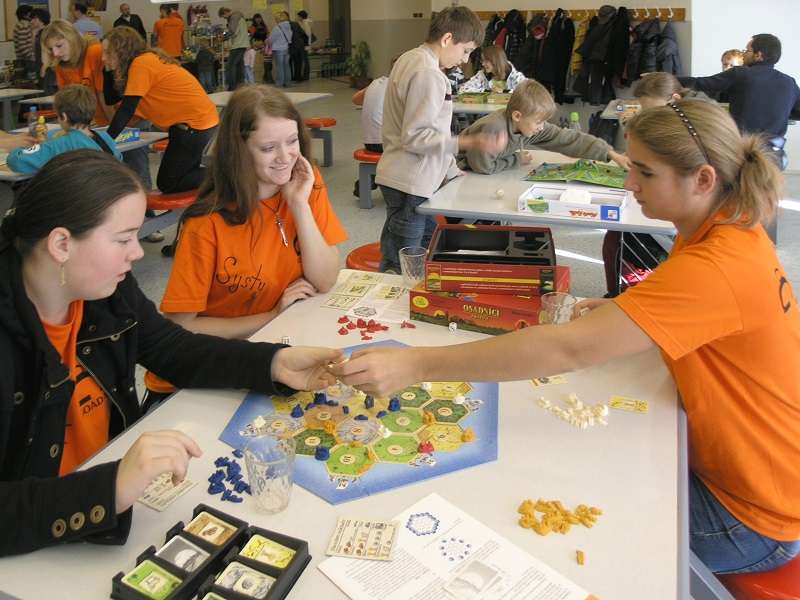Table of Contents
The Settlers of Catan often referred to as Catan or Settlers only is a multiplayer board game designed by Klaus Tuber. The game was first time published in 1995 in Germany by Kosmos. In the game, players take the role of settlers and attempt to build and develop holdings, while trading and acquiring resources.
Players score points with every increase in settlements and developments. The player who first reaches the threshold score wins the game. There are some extensions and various variants and expansions released until the date of this famous board game. In fact, this is the first German-style board game that went this much popular outside Europe. Around 30 million copies in 30 languages are sold across the world.
The Settlers of Catan- Base Game
The game starts with an assumption that after a long, tiring, and deprived voyage, the players at least come to the coast of an uncharted island, that is very rich in resources. They name the island as Catan, but the player is not alone to settle and utilized the resources of the rich island.

He has to go through competition for survival. So, the game is a race with other fearless explorers to settle the island. And it can be won through strong strategies, skillful trading, tactful expansions and obviously, the luck also plays a very pivotal role.
Game Rules
The first and foremost thing required to get the hold of the Catan is, obviously, strategy. The island has different patches that produce different resources. The resources can be used to build roads and new settlements and to develop these settlements into cities. But there could be an abundance of one resource and scarcity of others. The players have to barter one resource for others. The skill is needed to trade the resources and get the best. Every player needs to act tactfully to beat others. It is the war of all against all.

3-4 players can play the base Game if Catan. Before starting to play the board is build using the hexagonal terrain tiles. These tiles represent mountains, pastures, hills, fields, and forests surrounded by the mighty sea. Each tile produces a different resource. Initially, the tiles were arranged randomly, but the newer additions depict the fixed layouts in their manuals. This layout is proven to be fairly even-handed by computer simulation. Now they recommend using thus fixed layout by the beginners. Even the 2016 edition of the game has a fixed layout of the board, on which the hexes cannot be rearranged.
After arrangement, every player builds two houses as the initial settlement on the meeting point of any three hexes. Then they start rolling two dices. Every hex is marked with a number, and the players who own a settlement adjacent to the rolled number receive a resource associated with that terrain or hex. Cities produce two cards of the corresponding resource. The hills produce bricks, forest produces lumber, mountains give ore, fields yield grains and pastures produce wool. If a player has 1 city and two settlements adjacent to a grain hex, that player receives four-grain resource cards if the corresponding number is rolled.
The won resources are used to expand, and develop settlements. The settlements v=can be converted into the cities by using these resources. for instance, a road can be built by using 1 brick and 1 lumber. In case the required resources are not won, they can be acquired by the barter system.
Resource cards can also be used to buy a development card. Three types of development cards are: the cards that worth one victory point; knight cards (or soldier cards), which enable the player to move the robber token as if they had rolled a 7 without the remove-half rule; and a third set of cards which allow the player one of three abilities when played.
There is also a robber token, that is placed in the desert at the beginning. If a player rolled 7, the robber moves to another hex, which would not produce anything until the robber is moved again. The player with the robber on his hex can steal one resource card from another player with a settlement or city adjacent to the robber’s new placement. Further, if the 7 is rolled, all the players with 8 or more resource cards must discard half the resources of their choice.
The goal of the board game (https://www.pchelica.com/igracke/drustvene-igre.html) is to reach ten victory points. 1 settlement has 1 victory point and 1 city has 2. Various other achievements, such as establishing the establishment of the longest road and largest army grants player extra points, and whoever scores 10 points first is the winner.
Extensions of Settlers of Catan
The base game of Settlers of Catan was built to support up to 4 players. The company released an extension in 1996, that allows six players. It also includes extra components to accommodate more players. The expansion adds an extra building phase to the turn, that enables players to participate in the game during other player’s turn.

Since the game released, a number of computer games have been published based on Settlers of Catan and its Spinoffs. The first sanctioned English-language release was Catan: The Computer Game for the PC. The ultimate multi-platform version of Settlers of Catan allows the fans to play the game in Mac, Windows, and smartphones nada tablets. They support the original implementation including multiple extensions. And the best part is that this game can be played with players from all over the world or against clever computer opponents.
As mentioned before, the game has become very popular all over the world for its elemental simplicity. But this simplicity coats very beautifully, the breath-taking depth and breadth of experience. It is a resource management game, defined by position and strategizing. It is especially popular in the United States, where it is called “board game of our time” by The Washington Times. The game has won various awards since 1995.








